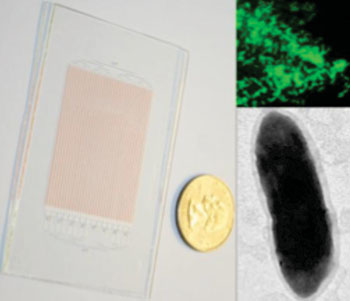Microfluidics Device Captures and Isolates Slow Growing Gut Bacteria
By LabMedica International staff writers
Posted on 16 Jul 2014
Microbiologists have used a novel "lab-on-a-chip" approach to isolate and cultivate fastidious, slow growing bacteria from the human digestive tract.Posted on 16 Jul 2014
The majority of microbes that comprises the human gut biome have not been cultured, due in part to the difficulties of both identifying proper growth conditions and characterizing and isolating each species.

Image: Glass SlipChip for growing microbes, shown next to a US quarter dollar coin (left); fluorescent in situ hybridization image of the target organism (right, top); transmission electron microscopy image of a single cell of the target organism (right, bottom) (Photo courtesy of the California Institute of Technology).
Investigators at the California Institute of Technology (Pasadena, USA) developed a microfluidics-based, genetically targeted approach to overcome these problems. Their "SlipChip" device was constructed from two glass slides, each the size of a credit card, that were etched with tiny grooves that became channels when the grooved surfaces were stacked atop one another. When a sample, such as a mixed assortment of bacterial species from a colonoscopy biopsy, was applied to the device, the interconnected channels of the top chip turned the channels into individual wells, with each well ideally holding a single microbe. Once sequestered in an isolated well, each individual bacterium was able to divide and grow without having to compete for resources with other types of faster-growing microbes.
The beauty of the system was that each well could be divided into two compartments. One compartment was used for DNA sequencing and mapping studies while the other maintained a living example of the microbe for further culture and study.
The investigators validated this approach by cultivating a bacterium from a human cecal biopsy. Genetic mapping of the organism showed that it was a representative of a previously unidentified genus of the Ruminococcaceae family and that its genetic signature was listed among the high-priority group of the [US] National Institutes of Health's Human Microbiome Project’s "Most Wanted" list.
"Although a genomic sequence of the new organism is a useful tool, further studies are needed to learn how this species of microbe is involved in human health," said senior author Dr. Rustem Ismagilov, professor of chemistry and chemical engineering at the California Institute of Technology.
The study was published in the June 25, 2014, online edition of the journal Proceedings of the National Academy of Sciences of the United States of America (PNAS).
Related Links:
California Institute of Technology













